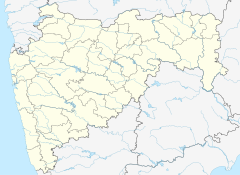
Lakshmi also known as Shri, is one of the principal goddesses in Hinduism. She is the goddess of wealth, fortune, power, beauty, fertility and prosperity, and associated with Maya ("Illusion"). Along with Parvati and Saraswati, she forms the Tridevi of Hindu goddesses.

Venkateshwara, Venkatachalapathi, Balaji, or Srinivasa, is a form of the Hindu deity Vishnu and is the presiding deity of the Venkateshwara Temple, located in Tirupati, Andhra Pradesh, India. Venkateshwara is also known by various other names. The deity is worshiped by North Indians by the name 'Balaji'.

Kolhapur is a city on the banks of the Panchganga River in the southern part of the Indian state of Maharashtra.
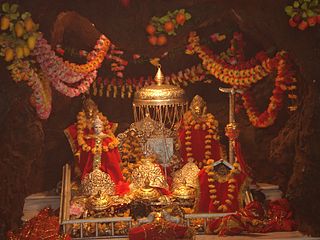
Vaishno Devi is a manifestation of the Hindu mother goddess Lakshmi sometimes in some beliefs Vaishno Devi is considered a manifestation of goddess Mahalakshmi. Vaishno Devi is worshipped as a combined avatar of the goddesses Mahakali, Mahalakshmi, and Mahasarasvati. Additionally, she is seen as the potency of Hari or Vishnu.

Tripura Sundari, also known as Rajarajeshvari, Shodashi, Kamakshi, and Lalita, is a Hindu goddess, revered primarily within the Shaktism tradition and recognized as one of the ten Mahavidyas. She embodies the essence of the supreme goddess Mahadevi. Central to the Shakta texts, she is widely praised in the Lalita Sahasranama and Saundarya Lahari. In the Lalitopakhyana of the Brahmanda Purana, she is referred to as Adi Parashakti.

The Shakti Pithas or the Shakti Peethas are significant shrines and pilgrimage destinations in Shaktism, the goddess-centric denomination in Hinduism. The shrines are dedicated to various forms of Adi Shakti. Various Puranas such as Srimad Devi Bhagavatam state the existence of a varying number of 51, 52, 64 and 108 Shakti Pithas of which 18 are named as Astadasha Maha (major) in medieval Hindu texts.

Bhadrakali is a Hindu goddess. She is considered to be the auspicious and fortunate form of Adi Shakti who protects the good, known as bhadra.

The Shilahara/Shelara Kingdom was a royal dynasty that established itself in northern and southern Konkan in 8th century CE, present-day Mumbai and Southern Maharashtra (Kolhapur) during the Rashtrakuta period.

Padmavati also known as Alamelu Manga is a Hindu goddess and the consort of the deity Venkateshvara, a form of Vishnu. She is described as a daughter of a local king and an avatar of goddess Lakshmi, the consort of Vishnu.
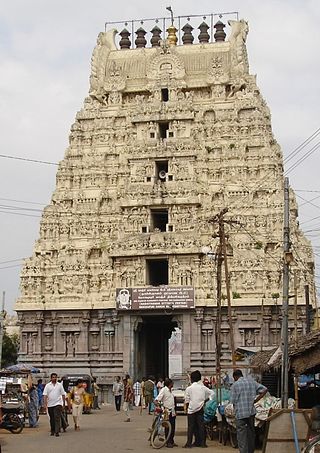
The Kamakshi Amman Temple, also known as Kamakoti Nayaki Kovil, is a Hindu temple dedicated to the goddess Kamakshi, one of the highest aspects of Adi Parashakti, the supreme goddess in Shaktism. The temple is located in the historic city of Kanchipuram, near Chennai, India.

Jainism in North Karnataka flourished under the Chalukyas, Kadamba, Rashtrakutas, and Vijayanagara Empire. Imbued with religious feeling, patronage was extended towards the building of Jain temple and it garnered high repute among the people, particularly the ruling classes and the mercantile community; effectively getting treated as the state religion.
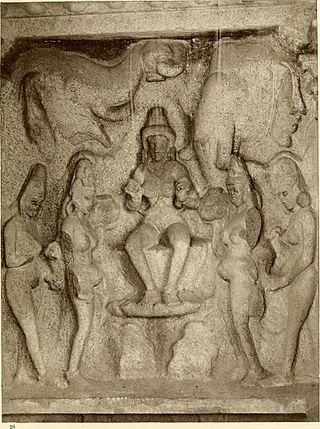
The Lakshmi Tantra is one of the Pancharatra texts that is dedicated to the goddess Lakshmi and Narayana (Vishnu) in Hinduism. It forms a part of the Agamas. The Lakshmi Tantra is devoted to the worship of the goddess Lakshmi, although it also glorifies all women in general.
Patan Devi, also called Maa Patneshwari, is the oldest and one of the most sacred temples of Patna, Bihar. It is regarded as one of the 51 Siddha Shakti Pithas in India. According to Puranic legends, the 'right thigh' of the corpse of Devi Sati had fallen here when it was chopped off by Lord Vishnu with his 'Sudarshan Chakra'. The ancient temple, originally called Maa Sarvanand Kari Patneshwari, is believed to be the abode of the goddess Durga.
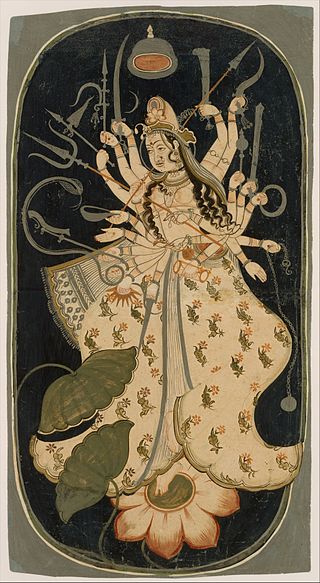
Mahadevi, also referred to as Adi Parashakti, Mahamaya and Durga, is the supreme goddess in Hinduism. According to the goddess-centric sect Shaktism, all Hindu gods and goddesses are considered to be manifestations of this great goddess, who is considered as the Para Brahman or the ultimate reality.

Kopeshwar Temple is at Khidrapur, Kolhapur district, Maharashtra. It is a Hindu temple dedicated to Shiva. This temple is in Maharashtra It is also accessible from Sangli as well. It was built in the 12th century by Shilahara king Gandaraditya between 1109 and 1178 CE. It is to the east of Kolhapur, ancient & artistic on the bank of the Krishna river. Even though Silaharas were Jain kings, they built and renovated various Hindu temples, thus depicting their respect and love for all religions. Kopeshwar means angry Shiva.

Jagadamba is an epithet used to address a Hindu goddess, primarily applied to Lakshmi and Parvati in literature.
Three and a half Shakti Peethas are reported in Maharashtra.

Mookambika is a Hindu goddess, an aspect of Adi Parashakti, the supreme goddess of Hinduism. She is regarded to be the form of shakti, the divine feminine energy, that represents creativity and ingenuity. She is widely worshipped in the states of Karnataka, Kerala and Tamil Nadu. Her most important abode is the Mookambika Temple located in Kollur village in Udupi district of coastal Karnataka.

The Humcha Jain temples or Humcha basadis are a group of temples found in Humcha village of Shimoga district in Karnataka, India. They were constructed in the 7th century CE in the period of the Santara dynasty and are regarded as one of the major Jain centres of Karnataka. The Padmavati Basadi is the most well-known of these temples.

